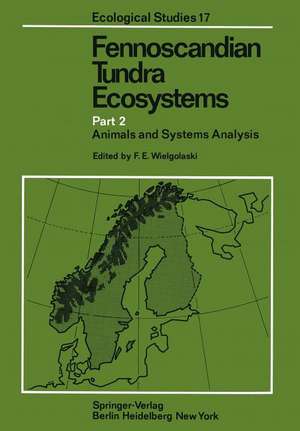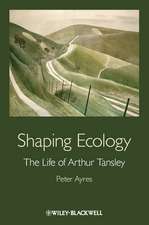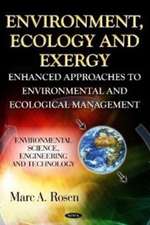Fennoscandian Tundra Ecosystems: Part 2 Animals and Systems Analysis: Ecological Studies, cartea 17
P. Kallio Editat de Frans Emil Wielgolaski H. Kauri, E. Ostbye, T. Rosswallen Limba Engleză Paperback – 13 dec 2011
Din seria Ecological Studies
- 18%
 Preț: 1118.93 lei
Preț: 1118.93 lei -
 Preț: 553.72 lei
Preț: 553.72 lei - 18%
 Preț: 1680.55 lei
Preț: 1680.55 lei - 18%
 Preț: 1003.38 lei
Preț: 1003.38 lei - 20%
 Preț: 1004.71 lei
Preț: 1004.71 lei -
 Preț: 480.62 lei
Preț: 480.62 lei - 5%
 Preț: 752.26 lei
Preț: 752.26 lei - 15%
 Preț: 643.99 lei
Preț: 643.99 lei - 15%
 Preț: 644.18 lei
Preț: 644.18 lei - 15%
 Preț: 652.49 lei
Preț: 652.49 lei - 18%
 Preț: 789.83 lei
Preț: 789.83 lei -
 Preț: 382.36 lei
Preț: 382.36 lei - 15%
 Preț: 643.48 lei
Preț: 643.48 lei - 15%
 Preț: 646.30 lei
Preț: 646.30 lei - 15%
 Preț: 634.32 lei
Preț: 634.32 lei -
 Preț: 384.86 lei
Preț: 384.86 lei - 18%
 Preț: 789.98 lei
Preț: 789.98 lei - 15%
 Preț: 645.14 lei
Preț: 645.14 lei - 15%
 Preț: 649.39 lei
Preț: 649.39 lei - 18%
 Preț: 1005.43 lei
Preț: 1005.43 lei - 18%
 Preț: 949.23 lei
Preț: 949.23 lei - 15%
 Preț: 649.54 lei
Preț: 649.54 lei - 15%
 Preț: 643.34 lei
Preț: 643.34 lei - 15%
 Preț: 649.71 lei
Preț: 649.71 lei - 15%
 Preț: 638.76 lei
Preț: 638.76 lei - 18%
 Preț: 957.62 lei
Preț: 957.62 lei - 18%
 Preț: 1235.25 lei
Preț: 1235.25 lei - 18%
 Preț: 962.18 lei
Preț: 962.18 lei - 18%
 Preț: 949.23 lei
Preț: 949.23 lei - 15%
 Preț: 660.68 lei
Preț: 660.68 lei -
 Preț: 397.76 lei
Preț: 397.76 lei - 15%
 Preț: 638.24 lei
Preț: 638.24 lei - 18%
 Preț: 942.31 lei
Preț: 942.31 lei - 18%
 Preț: 1232.57 lei
Preț: 1232.57 lei - 15%
 Preț: 651.34 lei
Preț: 651.34 lei - 18%
 Preț: 952.72 lei
Preț: 952.72 lei - 18%
 Preț: 1834.27 lei
Preț: 1834.27 lei - 18%
 Preț: 1229.10 lei
Preț: 1229.10 lei -
 Preț: 423.95 lei
Preț: 423.95 lei - 18%
 Preț: 948.92 lei
Preț: 948.92 lei
Preț: 645.79 lei
Preț vechi: 759.76 lei
-15% Nou
Puncte Express: 969
Preț estimativ în valută:
123.57€ • 134.65$ • 104.13£
123.57€ • 134.65$ • 104.13£
Carte tipărită la comandă
Livrare economică 23 aprilie-07 mai
Preluare comenzi: 021 569.72.76
Specificații
ISBN-13: 9783642662782
ISBN-10: 3642662781
Pagini: 356
Ilustrații: XIV, 338 p.
Dimensiuni: 170 x 244 x 19 mm
Greutate: 0.57 kg
Ediția:Softcover reprint of the original 1st ed. 1975
Editura: Springer Berlin, Heidelberg
Colecția Springer
Seria Ecological Studies
Locul publicării:Berlin, Heidelberg, Germany
ISBN-10: 3642662781
Pagini: 356
Ilustrații: XIV, 338 p.
Dimensiuni: 170 x 244 x 19 mm
Greutate: 0.57 kg
Ediția:Softcover reprint of the original 1st ed. 1975
Editura: Springer Berlin, Heidelberg
Colecția Springer
Seria Ecological Studies
Locul publicării:Berlin, Heidelberg, Germany
Public țintă
ResearchCuprins
of Part 2.- 1. Animals.- Area Size and Niche Breadth at Higher Latitudes.- 1.1. Faunal Structure of Research Areas.- Faunal Structure of Investigated Areas at Kevo, Finland.- Faunal Structure of Hardangervidda, Norway.- Faunal Structure of the IBP Tundra Site and Its Surroundings, Abisko, Sweden.- 1.2. Organization and Dynamics of Populations.- Dynamics of Enchytraeidae Populations on Hardangervidda.- Dynamics of Oribatei Populations on Hardangervidda.- Spider Populations in a Subalpine Birch Forest.- Organization and Dynamics of Collembola Populations on Hardangervidda.- Dynamics of Thysanoptera Populations on Hardangervidda.- Dynamics of Aphididae Populations on Hardangervidda.- Occurrence and Role of Different Invertebrate Groups in Alpine Salix herbacea Snowbeds at Hardangervidda.- Structure of Small Passerine Communities in Subalpine Birch Forests in Fennoscandia.- Density Variations of Bird Populations in High Mountain Habitats, Hardangervidda.- 1.3. Bioenergetics.- Influence of Various Temperature Approximations on Estimates of Field Respiration in a Mountain Community.- Respiration Rates, Winter and Summer Activity in Collembola on Hardangervidda.- Respiratory Rates and Respiratory Energy Loss in Terrestrial Invertebrates from Hardangervidda.- Energetics in a Population of Pardosa palustris (L.) (Araneae, Lycosidae) on Hardangervidda.- Life Cycle and Energy Budget of Tipula excisa (Schum.) (Diptera, Tipulidae).- Standing Crop and Calorific Content in Invertebrates from Hardangervidda.- Food Habits and Body Composition of Adult and Juvenile Meadow Pipit [Anthus pratensis (L.)].- Energy Budget of a Population of the Root Vole [Microtus oeconomus (Pall.)] in a High Mountain Habitat, Hardangervidda.- 1.4. Herbivory Aspects.- On the Ecocatastrophe of Birch Forests Caused by Oporinia autumnata (Bkh.) and the Problem of Reforestation.- Birch Herbivores and Herbivory at Kevo.- Importance Criteria in Birch Defoliators.- Wild Reindeer Food Habits and Range Use at Hardangervidda.- Reindeer Activity on Hardangervidda.- Grazing by Sheep.- 2. Conservation and Recreation in Tundra Ecosystems.- Stability of Tundra Ecosystems in Fennoscandia.- Remote Sensing of Vegetation in Conservation of Tundra Landscapes.- 3. Models for Integration and Prediction.- Principles in the Use of Wide-Scale Models on Tundra Data.- A Mathematical Simulation Model for Terrestrial Tundra Ecosystems.- Systems Analysis on Invertebrates.- A Simulation Model of a Small Rodent Population.- Energy Model for Individual Small Rodents and Its Significance in General Population Theory.- Functioning of Fennoscandian Tundra Ecosystems.














